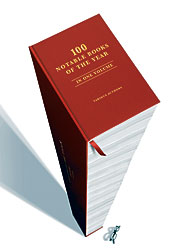 On November 27 the Pulitzer Prize Board announced that “newspapers may now submit a full array of online material-such as databases, interactive graphics, and streaming video-in nearly all of its journalism categories,” while the closest The New York Times’ 100 Notable Books of the Year came to documenting any changes in the publishing world is one graphic memoir (Fun Home by Alison Bechdel.)
On November 27 the Pulitzer Prize Board announced that “newspapers may now submit a full array of online material-such as databases, interactive graphics, and streaming video-in nearly all of its journalism categories,” while the closest The New York Times’ 100 Notable Books of the Year came to documenting any changes in the publishing world is one graphic memoir (Fun Home by Alison Bechdel.)
Only last year the Pulitzer Prize Board allowed for the first time some online content, but now, it will permit a broader, and much more current assortment of online elements, according to the different Pulitzer categories. The seemingly obvious restrictions are for photography, which permit still images only. They have decided to catch up with the times: “This board believes that its much fuller embrace of online journalism reflects the direction of newspapers in a rapidly changing media world,” said Sig Gissler, administrator of the Pulitzer Prizes. With its new rules for online submissions, the Pulitzer Board acknowledges that online elements such as a database, blog, interactive graphic, slide show, or video presentation count as items in the total number of elements, print or online, that can be considered worth a prize.
Even though the use of multimedia and computer technology has become ubiquitous not only in the media world but also in the performing arts, the book world seems absorbed in its own universe. The notion of “digital book” continues to mean digital copies of books and the consequent battle among those who want the lion’s share of the market (see “Yahoo Rebuffs Google on Digital Books”). And, when we talk about ebooks we mean devices for reading digital copies of books. Interestingly, most of the books published today are written, composed and set using electronic technology. So much of what we read online is full of distracting, sometimes quite interesting, advertising. On Black Friday, lots of people following the American tradition of shopping on that day did it online. It would seem that we are more than ready for real ebooks. I wonder how long it would take for one of them to hit the top lists of the year.
Category Archives: pulitzer
pulitzers will accept online journalism
Online news is now fair game for all fourteen journalism categories of the Pulitzer Prize (previously only the Public Service category accepted online entries). However, online portions of prize submissions must be text-based, and the only web-exclusive content accepted will be in the breaking news reporting and breaking news photography categories.  But this presumably opens the door to some Katrina-related Pulitzers this April. I would put my bets on nola.com, the New Orleans Times-Picayune site that kept reports flying online throughout the hurricane.
But this presumably opens the door to some Katrina-related Pulitzers this April. I would put my bets on nola.com, the New Orleans Times-Picayune site that kept reports flying online throughout the hurricane.
Of course, the significance of this is mainly symbolic. When the super-prestigious Pulitzer (that’s him to the right) starts to re-align its operations, you know there are bigger plate tectonics at work. This would seem to herald an eventual embrace of blogs, most obviously in the areas of commentary, beat reporting, community service, and explanatory reporting (though investigative reporting may not be far off). The committee would do well to consider adding a “news analysis” category for all the fantastic websites, many of them blogs, that help readers make sense of the news and act as a collective watchdog for the press.
Also, while the Pulitzer changes evince a clear preference for the written word, it seems inevitable that inter-media journalism will continue to gain in both quality and legitimacy. We’ll probably look back on all the Katrina coverage as the watershed moment. Newspapers (some of them anyway) will figure out that to stay relevant, and distinctive enough not to be pulled apart by aggregators like Google or Yahoo news search, they will have to weave a richer tapestry of traditional reporting, commentary, features, and rich multimedia: a unique window to the world.
Nola.com didn’t just provide good, constant coverage, it saved lives. It was an indispensible, unique portal that could not be matched by any aggregator (though harnessing the power of aggregation is part of what made it successful). The crisis of the hurricane put in relief what could be a more everyday strategy for newspapers. The NY Times currently is experimenting with this, developing a range of multimedia features and cordoning off premium content behind its Select pay wall. While I don’t think they’ve yet figured out the right combination of premium content to attract large numbers of paying web subscribers, their efforts shouldn’t necessarily be dismissed.
Discussions on the future of the news industry usually center around business models and the problem of solvency with a web-based model. These questions are by no means trivial, but what they tend to leave out is how the evolving forms of journalism might affect what readers consider valuable. And value is, after all, what you can charge for. It’s fatalistic to assume that the web’s entropic power will just continue to wear down news institutions until they vanish. The tendency on the web toward fragmentation is indeed strong, but I wouldn’t underestimate the attraction of a quality product.
A couple of years ago, file sharing seemed to spell doom for the music industry, but today online music retailers are outselling most physical stores. Perhaps there is a way for news as well, but the news will have to change. Dan Gillmor is someone who has understood this for quite some time, and I quote from a rather prescient opinion piece he wrote back in 1997 when the Pulitzers were just beginning to wonder what to do about all this new media (this came up today on the Poynter Online-News list):
When we take journalism into the digital realm, media distinctions lose their meaning. My newspaper is creating multimedia journalism, including video reports, for our Web site. We strongly believe that the online component of our work augments what we sometimes call the “dead-tree” edition, the newspaper itself. Meanwhile, CNN is running text articles on its Web site, adding context to video reports.
So you have to ask a simple question or two: Online, what’s a newspaper? What’s a broadcaster?
Suppose CNN posts a particularly fine video report on its Web site, augmented by old-fashioned text and graphics. If the Pulitzer Prizes are o pen to online content, the CNN report should be just as valid an entry as, say, a newspaper series posted online and augmented with video.
And what about the occasionally exceptional journalism we’re seeing from Web sites (or on CD-ROMs) produced by magazines, newsletters, online-only companies or even self-appointed gadflies? Corporate propaganda obviously will fail the Pulitzer test, but is a Microsoft-sponsored expose of venality by a competitor automatically invalid when it’s posted on the Microsoft Network news site or MSNBC? Drawing these lines will take serious wisdom, unless the Pulitzer people decide simply to ignore trends and keep the prizes the way they are, in which case the awards will become quaint – or worse, irrelevant.
I’m also intrigued by another change made by the Pulitzer committee (from the A.P.):
In a separate change, the upcoming Pulitzer guidelines for the feature writing category will give ”prime consideration to quality of writing, originality and concision.” The previous guidelines gave ”prime consideration to high literary quality and originality.”
Drop the “literary” and add “concision.” A move to brevity and a more colloquial character are already greatly in evidence in the blogosphere and it’s beginning to feed back into the establishment press. Employing once again the trusty old Pulitzer as barometer, this suggests that that most basic of journalistic forms — “the story” — is changing.
